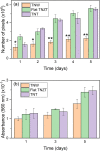Proliferation of osteoblast precursor cells on the surface of TiO2 nanowires anodically grown on a β-type biomedical titanium alloy
- PMID: 35551497
- PMCID: PMC9098445
- DOI: 10.1038/s41598-022-11981-4
Proliferation of osteoblast precursor cells on the surface of TiO2 nanowires anodically grown on a β-type biomedical titanium alloy
Abstract
Studies have shown that anodically grown TiO2 nanotubes (TNTs) exhibit excellent biocompatibility. However, TiO2 nanowires (TNWs) have received less attention. The objective of this study was to investigate the proliferation of osteoblast precursor cells on the surfaces of TNWs grown by electrochemical anodization of a Ti-35Nb-7Zr-5Ta (TNZT) alloy. TNT and flat TNZT surfaces were used as control samples. MC3T3-E1 cells were cultured on the surfaces of the samples for up to 5 days, and cell viability and proliferation were investigated using fluorescence microscopy, colorimetric assay, and scanning electron microscopy. The results showed lower cell proliferation rates on the TNW surface compared to control samples without significant differences in cell survival among experimental conditions. Contact angles measurements showed a good level of hydrophilicity for the TNWs, however, their relatively thin diameter and their high density may have affected cell proliferation. Although more research is necessary to understand all the parameters affecting biocompatibility, these TiO2 nanostructures may represent promising tools for the treatment of bone defects and regeneration of bone tissue, among other applications.
© 2022. The Author(s).
Conflict of interest statement
The authors declare no competing interests.
Figures









References
-
- Boyer RR. An overview on the use of titanium in the aerospace industry. Mater. Sci. Eng. A. 1996;213:103–114. doi: 10.1016/0921-5093(96)10233-1. - DOI
-
- Ridzwan MIZ, Shuib S, Hassan AY, Shokri AA, Mohammad Ibrahim MN. Problem of stress shielding and improvement to the hip implant designs: A review. J. Med. Sci. 2007;7:460–467. doi: 10.3923/jms.2007.460.467. - DOI
-
- Bahraminasab M, Sahari BB, Edwards KL, Farahmand F, Arumugam M. Aseptic loosening of femoral components: Materials engineering and design considerations. Mater. Des. 2013;44:155–163. doi: 10.1016/j.matdes.2012.07.066. - DOI
-
- Nasibi S, et al. TZNT alloy for surgical implant applications: A systematic review. J. Compos. Compd. 2020;2:61–67.
Publication types
MeSH terms
Substances
LinkOut - more resources
Full Text Sources

